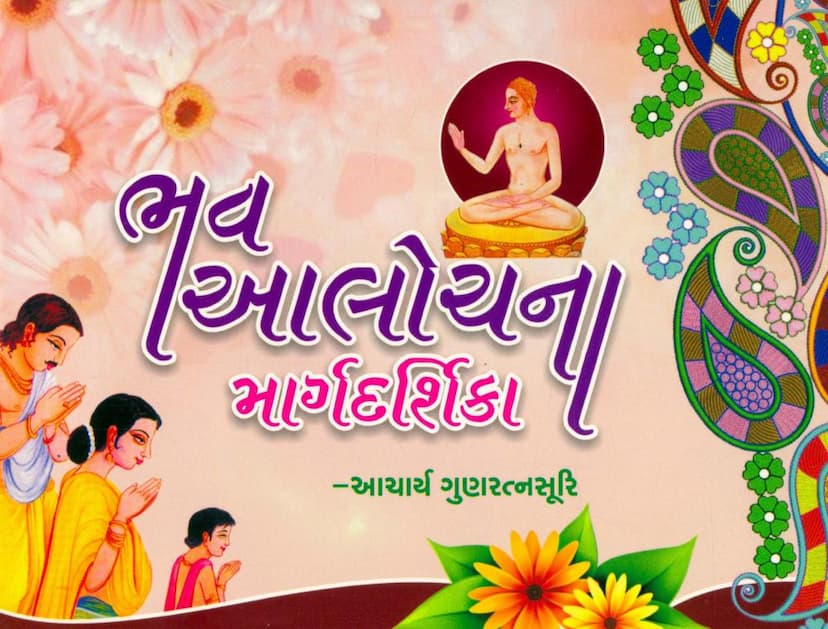Bhav Alochna Margdarshika
Added to library: September 1, 2025

Summary
This document, "Bhav Alochna Margdarshika" (Guide to Life's Self-Reflection), authored by Acharya Gunratnasuri and compiled by Acharya Rashmiratnasuri, published by Jingun Aradhak Trust, is a comprehensive guide to self-reflection and confession within the Jain tradition.
The core purpose of the book is to guide individuals in identifying and confessing their wrongdoings (doshas) to achieve spiritual purification and progress towards liberation (moksha).
Key Themes and Concepts:
- The Cycle of Karma and Rebirth: The text begins by explaining that souls are trapped in the cycle of birth and death due to karma. While good karma brings happiness and bad karma brings suffering, the focus is on the karmas that lead to sinful actions and bind the soul.
- The Power of Mohaniya Karma: It highlights "Mohaniya Karma" (delusion-inducing karma) as the most destructive, causing attachment (rag) to pleasure and aversion (dwesh) to pain, leading the soul astray.
- The Importance of "Alochna" (Confession/Reflection): The book emphasizes that "Alochna" is the primary means to cleanse the soul. It compares it to washing dirty clothes with soap or surgically removing a tumor to save a life.
- Analogy to a Clean Cloth: Just as a dirty cloth becomes clean with soap, the soul becomes pure through "Alochna."
- Examples from Jain Lore: The text references exemplary figures like Rukmini and Sadhviji Lakshmana, who achieved liberation through "Alochna," underscoring its significance.
- The Process of Self-Reflection: It guides the reader on how to write down their confessions, encouraging complete honesty and detailing the nature of the mistake (e.g., intentional or unintentional, the mindset behind it).
- Detailed Catalogue of Transgressions: The bulk of the book is a comprehensive list of potential transgressions, categorized broadly. This list serves as a checklist for self-examination. The categories include:
- Samyak Darshan ke Dosho ki Vigat (Faults related to Right Faith): Covering doubts about religious tenets, admiration for other faiths, disrespect towards the Jain faith, and condemning virtuous individuals.
- Samyak Gyan ke Dosho ki Vigat (Faults related to Right Knowledge): Including disrespect towards scriptures, improper study habits, damaging learning materials, and misuse of knowledge.
- Anuvarat ke Dosho ki Vigat (Faults related to the Lesser Vows): This forms a significant portion and lists transgressions related to:
- Pranaatipata Viraman (Abstinence from Harming Life): Detailing various ways of harming living beings, from micro-organisms to humans.
- Mrishavada Viraman (Abstinence from False Speech): Covering different types of lies, deceit, slander, and harsh speech.
- Adattadana Viraman (Abstinence from Stealing): Including various forms of theft, dishonesty in trade, and misusing resources.
- Maithuna Viraman (Abstinence from Illicit Sexual Conduct): Discussing a wide range of inappropriate thoughts and actions related to sexuality.
- Parigraha Viraman (Abstinence from Excessive Possession): Covering greed, unethical practices for wealth accumulation, and attachment to possessions.
- Digparibhasha (Limitation of Directions): Briefly touching upon transgressions related to travel and movement.
- Lokopabhoga (Enjoyment of Worldly Pleasures): Listing forbidden foods and drinks, and improper consumption.
- Anarthadanda Viraman (Abstinence from Useless Harm): Encompassing actions that cause unnecessary harm or promote violence.
- Specific Vows: The later sections delve into transgressions related to specific vows like Samayika (meditation), Paushadh (fasting), Deshavagashika (partial vows), and Atithisamvibhaaga (hospitality to monks/nuns).
- The Role of the Guru: The book emphasizes the importance of confessing these faults to a Guru (spiritual teacher) who will then prescribe penance (prayaschit).
- Penance and Purification: The final sections provide space for the Guru to fill in the prescribed penance, which could include fasting, reciting mantras, or other forms of austerity. The text concludes with blessings for the soul who has undergone this process of purification.
Overall Purpose:
"Bhav Alochna Margdarshika" is a practical and detailed manual for Jains seeking spiritual growth. It provides a framework for introspection, encourages accountability for one's actions, and offers a path towards inner peace and eventual liberation by confessing sins to a Guru and undertaking penance. The extensive list of transgressions serves as a guide to help individuals become aware of even subtle deviations from righteous conduct.